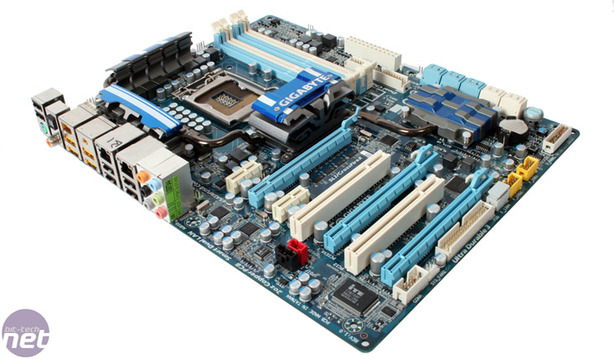Stability
As usual we reset the BIOS to its default values and loaded up both Prime95 torture test and 3DMark06 looping to see if the board could withstand the stress to CPU, memory and PCI Express power draw for 24 hours. Apart from a fan to cool the CPU heatsink, there were no other fans used, meaning the heatsinks have to withstand very little airflow and still keep cool.We found the Gigabyte P55-UD5 board ran 3DMark06 for the full 24 hours, but that Prime95 gave out and closed itself after just thirteen hours - an almost identical result to the P55M-UD4 we tested previously. Overall, the system was still stable and usable after the test finished, even if it survived for less time than the MSI board which ran Prime95 for 15 hours, and the Asus board which survived the full 24. At least the Gigabyte didn't completely fall over when extensive load was applied and we still rate this as a pretty good result.
Value and Conclusion
We can pick up the P55-UD5 for around £145, but it's also available for £160 elsewhere! That's a lot of cash to splash on a P55 board when X58s can be had for the same price, although we doubt you'll find one with the same breadth of features from the latter.You've got to really want the extra PCI-Express slot, use all the ten SATA ports and have gizmos galore for the jam-packed rear I/O, for this to be an value attractive option. The UD4 (micro-ATX and full ATX) can be had for much less: £115 to £125 and it's nearly all there too. That's not to say it won't be appealing for more demanding users though, and we appreciate Gigabyte has a range of boards to cater for a lot of tastes, but we cannot ignore the astronomical difference in price for a single step up the ladder.
The overclocking is pretty similar for both Gigabyte boards too, so there isn't "extra" here we can attribute more money to, and it's still missing crucial tweaking features such as an onboard diagnostic LED readout the UD6 has - that should be standard further down the range in our opinion - not to mention bits like voltage check points MSI offers. This is why the value score suffers: not because it's "expensive", but all the UD5 is, is more of the same, rather than it having successively more new hardware layered on for a more compelling purchase.
That's not to dissuade people from a Gigabyte board though - both we've seen have excellent BIOSes, dual BIOS for fail-safe reliability and over 200MHz baseclock is certainly achievable in the right environment. Performance is generally above average, although not unanimously so, as the SATA still has idle performance issues and the USB hits a bump too it seems.
Some of the layout is a bit naff, but overall it works with a generally good looking design but we appreciate the angular heatsinks can be an acquired taste. There are few faults with the Gigabyte GA-P55-UD5, but you've got to really need all the features to buy one, and given the fact the "A" series boards with SATA 6Gbps and USB 3 are already here just two months after the original release - it really does kill any potential value in a purchase. Checkout the much cheaper UD3 or UD4s that are 90 per cent of the same board for a more compelling Gigabyte P55 purchase.
- Performance
- x
- x
- x
- x
- x
- x
- x
- -
- -
- -
- 7/10
- Features
- x
- x
- x
- x
- x
- x
- x
- x
- -
- -
- 8/10
- Value
- x
- x
- x
- x
- x
- -
- -
- -
- -
- -
- 5/10
- Overall
- x
- x
- x
- x
- x
- x
- -
- -
- -
- -
- 6/10

MSI MPG Velox 100R Chassis Review
October 14 2021 | 15:04










Want to comment? Please log in.